Micro Biology > EXAM > EXAMINATION TESTS OF MICROBIOLOGY VIROLOGY AND IMMUNOLOGY DISCIPLINE (All)
EXAMINATION TESTS OF MICROBIOLOGY VIROLOGY AND IMMUNOLOGY DISCIPLINE
Document Content and Description Below
EXAMINATION TESTS OF MICROBIOLOGY VIROLOGY AND IMMUNOLOGY DISCIPLINE Basic bacteriology 1. Who first designed the microscope, saw and sketched microbes? A. Louis Pasteur B. Robert Koch C. Ilya Mechn... ikov D. Dmitri Ivanovsky E. Antonie Philips van Leeuwenhoek 2. Without which structures, bacteria cannot carry out their activities? A. Capsule B. Spors C. Volutine granules D. Nucleoid E. Flagella 3. What structure determines the shape of a bacterial cell? A. Cytoplasmic membrane B. Capsid C. Capsule D. Spore E. Cell wall 4. Bacteria as a unicellular microbes, that are without a nuclear membrane, belong to which Kingdoms? A. Eukaryotes B. Priones C. Prokaryotes D. Viruses E. Fungi 5. What is the significant structural component of a bacterial cell? A. Capsule B. Flagella C. Spore D. Cell wall E. Volutine granules 6. From what structural element of bacteria does Gram stain depend on? A. Structure of plasma membrane B. Сomposition of cytoplasme C. Structure of cell wall D. Arraignment of nucleoid E. Сomposition of Volutine granules 7. The structure of what morphological components determines Gram staining? A. Cytoplasm B. Capsule C. Cell wall D. Plasma membrane E. Volutine granules 8. Which step or dye does not use in Gram staining? A. Alcohol discoloration B. Fuchsin red C. Crystal violet D. Heating over the spirit lamp E. Iodine solution 9. What is the reason for the acid fastness of bacteria? A. Presence of carbohydrates B. Presence of glycogen C. Presence of proteins D. Presence of lipids E. Presence of peptidoglycan 10. What is the difference of cell wall structure between gram positive and gram negative bacteria? A. One layer of peptidoglycan B. Lipopolysaccharide C. Teichoic acids D. Mitochondria E. Mesosomes 11. What types of nutrition do have pathogenic bacteria? A. Metatrophs B. Autotrophs C. Paratrophs D. Heterotrophs E. Auxotrophs 12. What mechanism is carried out with the active transport of nutrients into the cell? A. Without cleavage of the substrate B. None of listed bellow C. Without energy costs D. By concentration of gradient E. Against a concentration gradient 13. What is sterilization method completely destroys microbes in the material? A. Autoclaving B. Pasteurization C. Filtration D. Tindalization E. Drying 14. Which structure does determine the ability of bacteria to attach to the surface of host cells? A. Cell wall B. Mesosomes C. Fimbria D. Flagella E. Plasma membrane 15. What is the function of nucleoid? A. To keep the shape of bacteria B. To keep osmotic pressure C. To keep hereditary information D To keep cell’s metabolism E. To keep protein synthesis 16. What is the function of cell wall? A. Formative B. Spore-forming C. Capsule-forming D. Enzyme-forming E. Energy-generating 17. What is the importance of chemical composition of the cell wall? A. Protein Synthesizing System B. Contains ribosomes for protein synthesis C. This structure is the same for all bacteria D. Keeps hereditary information E. It is responsible for Gram staining 18. What is the function of cytoplasmic membrane in bacteria? A. Gives shape to cells B. Involved in the transport of substances C. Participates in protein synthesis D. Causes cell sensitization. E. Causes cell chemotaxis 19. Which is always present in bacteria ? A. Cell wall B. Cytoplasmic membrane C. Mitochondria D. Nucleoli E. Volutin granules 20. Teichoic acids: A. Are found in the walls of many gram-positive bacteria B. Make up the outer wall of bacteria C. Provide receptors for phages D. Influence the permeability of membrane E. All are true 21. Mesosomes in bacteria are functional unit for : A. Lipid storage B. Protein synthesis C.Respiratory enzymes D.None E. All 22. Essential structures for bacteria: A. Capsule B. Spores C. Volutin granules D. Nucleoid E. Flagella 23. The presence of the cell wall is determined by: A. Fluorescent microscopy B. The “crushed drop” method C. By the “thick drop” method D. Ultracentrifugation E. Plasmolite 24. The shape of the bacterial cell is determined by the structure: A. Cytoplasmic membrane B. Capsid C. Capsules D. Spores E. Cell wall 25. Bacteria refer to: A. Eukaryotes B. Prions C. Prokaryotes D. All three E. None of them 26. A prokaryotic cell has: A. Golgi Apparatus B. Mitochondria C. Morphologically formed core D. Mesosomes E. Nuclear membrane 27. The morphology of the bacteria is studied: A. Dry Microscope System B. In unpainted preparations C. Immersion microscopy D. With a small increase E. None of the above 28. Essential structural component of the bacterial cell: A. Capsule B. Flagella C. Spores D. Cell wall E. Volutin granules 29. Gram stain depends on: A. Structures of the cytoplasmic membrane B. The composition of the cytoplasm C. Cell wall structures D. Core Locations E. From all listed signs 30. What are the morphological structures of bacteria cause gram stain ? A. Cytoplasm B. Capsule C. Cell wall D. Cytoplasmic membrane E. Volutin granule 31. The acid resistance of the microbial cell is associated with the presence of a large number: A. Carbohydrate B. Glycogen C. Protein D. Lipids E. Tryptophan 32. The cell wall of gram-positive bacteria contains: A. Monolayer Peptidoglycan B. Lipopolysaccharide C. Teichoic Acids D. Mitochondria E. Mesosomes 33. The cell wall of gram-negative microbes contains: A. Multilayer peptidoglycan B. Volutin granule C. Lipopolysaccharide D. Mesosomes E. Teichoic Acids 34. Microorganisms lose the cell wall under the action of: A. Bacteriophage B. Interferon C. Immunoglobulin D. Lysozyme E. Nucleases 35. A terminal spore resembling a drumstick is characteristic of: A. Cl. perfringens B. Cl. novyi C. Cl. tetani D. Cl. botulinum E. Cl. septicum 36. Spiral forms have: A. Chlamydia B. Borrelia C. Cocci D. Bacteria E. Mycoplasma 37. Spore-forming microorganisms of a spindle-shaped form are called: A. Bacilli B. Bacteria C. Bipolar D. Clostridia E. Rickettsia 38. Which one of the following bacteria is cell wall deficient? A. Escherichia coli B. Mycoplasma C. Salmonella typhi D. Treponema pallidum E. Clostridium botulinum 39. About Volutine granule is true except: A. Available from Corynebacterium diphtheria B. Participate in sporulation C. Storage of nutrients D. Composition - polyphosphate E. For tinctorial properties - metachromatic 40. Volutin granule according to the author are: A. Lipsha B. Babes-Ernst C. Babesha-Negri D. Pashena E. Guarnieri 41. Generation time of Mycobacterium tuberculosis is about? A. 20 seconds B. 20 minutes C. 20 hours D. 20 days E. 2 weeks 42. Active transport of nutrients into the cell goes: A. Without splitting the substrate B. None of the above C. Without energy D. By concentration gradient E. Against concentration gradient 43. Antigenic and biochemical properties of bacteria help determine: A. Morphology of microorganisms B. Species and intraspecific differences C. Antibiotic Sensitivity D. Phagolability E. Tinctorial properties 44. Prokaryotes are characterized by the presence of: A. Separated core B. Disjunctive reproduction C. Nuclear membrane D. Mitochondria E. Cytoplasmic membrane 45. The nucleoid of bacteria: A. Compact B. Has a nuclear envelope C. Is a plasmid D. Double stranded circular DNA E. Single-stranded RNA 46. The function of the nucleoid: A.Synthesis of proteins B. Regulation of osmotic pressure C. Preservation of hereditary information D. Energetic cell metabolism E. Production of pathogenicity factors 47. Cell wall function: A. Gives bacteria a specific shape B. Does not contain peptidoglycan. C. Participates in the synthesis of vitamins D. Is vital structure E. Participates in oxygenic processes 48. Bacteria cell wall: A. Is a protein synthesis system of the cell B. Contains ribosomes for protein synthesis C. Structure and chemical composition is the same for all bacteria. D. Saves Genetic Information E . Causes the relation to coloring across 49. Structures required for L-forms of bacteria: A. Cell wall B. Flagella C. Capsule D. Cytoplasmic membrane E . Plasmids 50. Bacteria without a cell wall: A. Rickettsia B. Spirochetes C. Actinomycetes D. Chlamydia E. Mycoplasma 51. Bean-shaped diplococci belong to the genus: A. Mycobacterium B. Treponem C. Neisseria D. Chlamydia E. Leptospira 52. Lipopolysaccharides contained in the cell wall of bacteria are: A. Exotoxins B. Endotoxins C. Enzymes D. Electrolytes E. Products of metabolism 53. Lipopolysaccharide cell wall: A. Does not possess antigenic and toxic properties B. Gives stiffness and elasticity. C. Activates the complement D. Is a strong immunogenic E. Contained in gram-positive bacteria 54. The cytoplasmic membrane of bacteria: A. Defines cell shape B. Participates in the transport of substances C. Is a protein synthesizing system D. Causes cell sensitization E. Is a chemotaxis factor 55. The cytoplasmic membrane is: A. Peptidoglycan consisting of parallel polysaccharide chains B. The pronounced mucous layer covering the cell wall C. Double phospholipid layer permeated with globulins D. Inhibitor of bacterial cell wall synthesis E. Complex nucleoprotein 56. The value of the cytoplasmic membrane of bacteria: A. Has selective permeability B. Stores the hereditary information of the bacterial cell C. Participates in conjugation D. Limits the core E. Regulates the immune response 57. Bacterial cytoplasm: A. Consists of mitochondria B. Contains differentiated core C. It is a complex colloidal system. D. Does not contain ribosomes E. Enhances virulence 58. Bacterial mesosomes: A. Participate in cell division B. Derived cell wall C. Not bound to nucleoid D. Are equivalent of nucleus E. Strengthen biochemical activity 59. The role of the capsule in the functioning of bacteria: A. Is a required structural component of the cell B. Is not strengthening virulence C. Activate phagocytosis D. Is an osmotic barrier E. Strengthen the protective factors of the microorganism 60. The bacterial capsule is characterized by: A. Easy to stain B. High lipid content C. Antigen specificity D. Acid Resistance E. Oncogenicity 61. The conditions stimulating the capsulation of bacteria is their growth in: A. In an animal organism B. On blood agar C. On synthetic medium D. On a high carbohydrate environment E. At low temperatures 62. The bacterial capsule is detected: A. In a phase contrast microscope B. Staining by Albert C. Staining by Indian ink D. Fluorescent microscopy E. In the experience of plasmolysis cells 63. Capsules in the body are formed by pathogens: A. Tuberculosis B. Typhus fever C. Anthrax D.Dysentery E. Leprosy 64. Constantly (in the body and in the external environment) pathogens form a capsule: A. Gas gangrene B. Typhoid fever C. Rhinoscleroma D. Cholera E. Diphtheria 65. Flagella of bacteria: A. Participate in multiplication B. Are antigens C. cause bipolar coloration D. Serve to preserve the species. E. Consist of carbohydrates 66. The mobility of bacteria is determined by: A. Polymerase reaction B. In the hanging drop preparation C.Luminescent microscopy D. Coloring method by Indian ink E.Gram staining 67. The motility of bacteria is provided by: A. Reduced cell wall B. Rotation of flagella C. Fimbrias (pili) D. enzyme activity E. None of the above 68. Pili cause: A. Motility B. Transformation C. Conjugation D. Transcription E. Replication 69. Peritrich flagella are characteristic of pathogens: A. Cholera B. Tuberculosis C. Typhoid fever D. Dysentery E. Diphtheria 70. Sporulation occurs under the following conditions: A. Favorable external environment B. Radiation C. Internal body environment D.High osmotic pressure E. Stay in the soil 71. Microbial spores are important for: A. Multiplication B. Amplification C. Preservation of species D. Participation in the metabolism E. Hybridization 72. Spores can form the following forms of microbes: A. Spirils B. All rod shape bacteria C. Some types of rod-shaped D. Cocci E. Filamentary 73. Have the ability to spore-forming: A. The simplest B. Bacteria C. Klebsiella D. Bacilli E.Rickettsia 74. The high stability of the spore is due to: A. The composition of the nucleoid B. Structure and chemical composition of the shell C. Increased potassium concentration D. High free water E. Glycogen content 75. Spores form pathogens: A. Diphtheria B. Typhus fever C. Tetanus D. Leprosy E. Gonorrhea 76. The value of volutin granules: A. Protection against adverse factors B. Preservation of cell shape C. Storage of nutrients D. Participation in reproduction E. Preservation of the species 77. Albert staining is used to identify: A. Spores B. Flagella C. Nuclear substance D. Capsules E. Granules of volutin 78. Albert staining we use: A. Gentian violet solution B. Methylene blue C. Acetic acid solution of methylene blue D. Fuchsin solution E. Alcohol 79. Volutin granules are detected by coloring according to the method: A. Gram B. Ziel-Nielsen C. By methylene blue D. By Indian ink E. Romanovsky - Giemsa 80. Preparation of the drug for microscopic examination includes: A. Drying out a smear in a Pasteur oven. B. Drying the smear in the flame. C. Smear fixation in flame. D. Filtration E. Coloring bacteria without fixation. 81. Native non-stained preparations are prepared for microscopy: A. Stereoscopic B. Polarization C. Fluorescent D. Phasic Contrast E. Electronic 82. When smear fixation occurs: A. Activation of microbes. B. Reduced optical density C. Attaching to glass D. Not susceptibility to the dye. E. Detection of antigens. 83. A simple staining method allows in a microbial cell: A. Detect the shell B. Determine the form C. Detect nucleoid D. Examine the ultrastructure E. Identify antigens 84. The ability to receive dyes (tinctorial properties of bacteria) determine the structure and composition: A. Cytoplasm B. Cytoplasmic membrane C. Capsules D. Plasmid E. Cell wall 85. When coloring by the Gram method, apply ? A. Carbol solution of gentian violet B. Carbol solution of fuchsin C. Vesuvine D. Methylene blue E. Acid treatment 86. Ziehl-Nielsen staining is used to identify: A. Nuclear substance B. Inclusions C. Acid-Resistant Microbes D. Motile microbes E. Capsular microbes 87. When painting according to Ziehl-Nielsen, apply: A. Acetic acid solution of methylene blue B. Carbol solution of fuchsin C. Solution of fuchsin D. Iodine solution E. Ethyl alcohol 88. The acid resistance of microorganisms is associated with the presence of: A. Nucleic acids B. High salt concentrations C. Polysaccharides D. Fatty substances E. Multilayer peptidoglycan 89. Acid-resistant bacteria include pathogens: A. Pneumonia B. Actinomycosis C. Tuberculosis D. Brucellosis E. Leptospirosis 90. Gram stain depends on: A. Shapes and sizes of cells B. Forms of colonies C. Features of the cytoplasmic membrane D. Peptidoglycan content E. Presence of flagella 91. Gram stained positively: A. Bacilla B. Escherichia C.Gonococci D. Rickettsia E. Spirochetes 92. For morphology, spirochete is characterized by: A. Rod-shaped B. Elastic axial thread C. Differentiated core D. Immobility E. Sporulation 93. Each kind of spirochete is different: A. The number and shape of curls B. Intracellular parasitism C. Type of food D. Relation to Gram stain E. Ability to lyse red blood cells 94. Spirochete morphology is studied: A. In preparations [Show More]
Last updated: 11 months ago
Preview 1 out of 156 pages
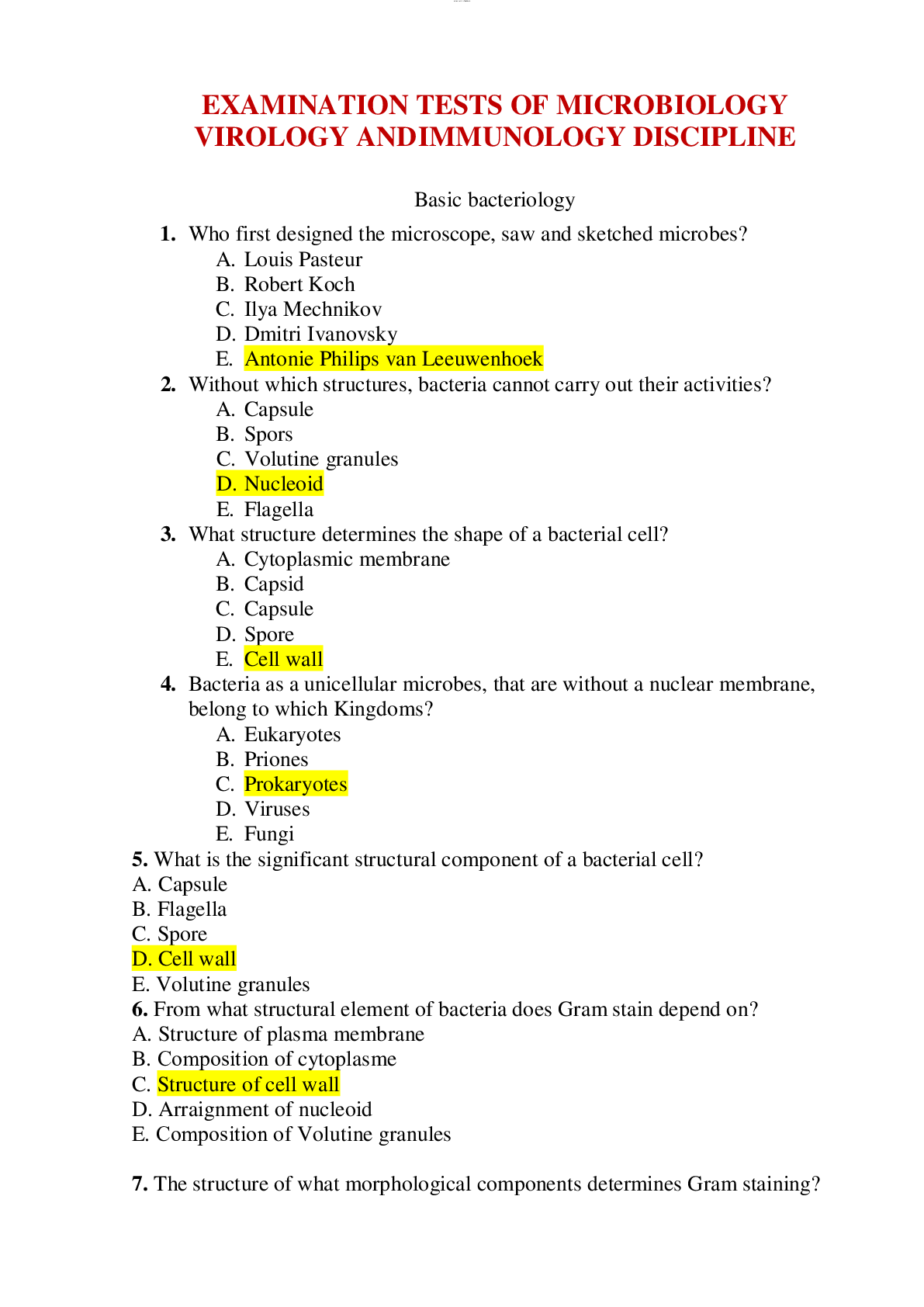
Reviews( 0 )
Recommended For You
Applied Science> EXAM > RBT Training Flashcards - RBT Training Modules | 281 Questions and Answers 100% Correct | COMPLETE | 42 Pages (All)
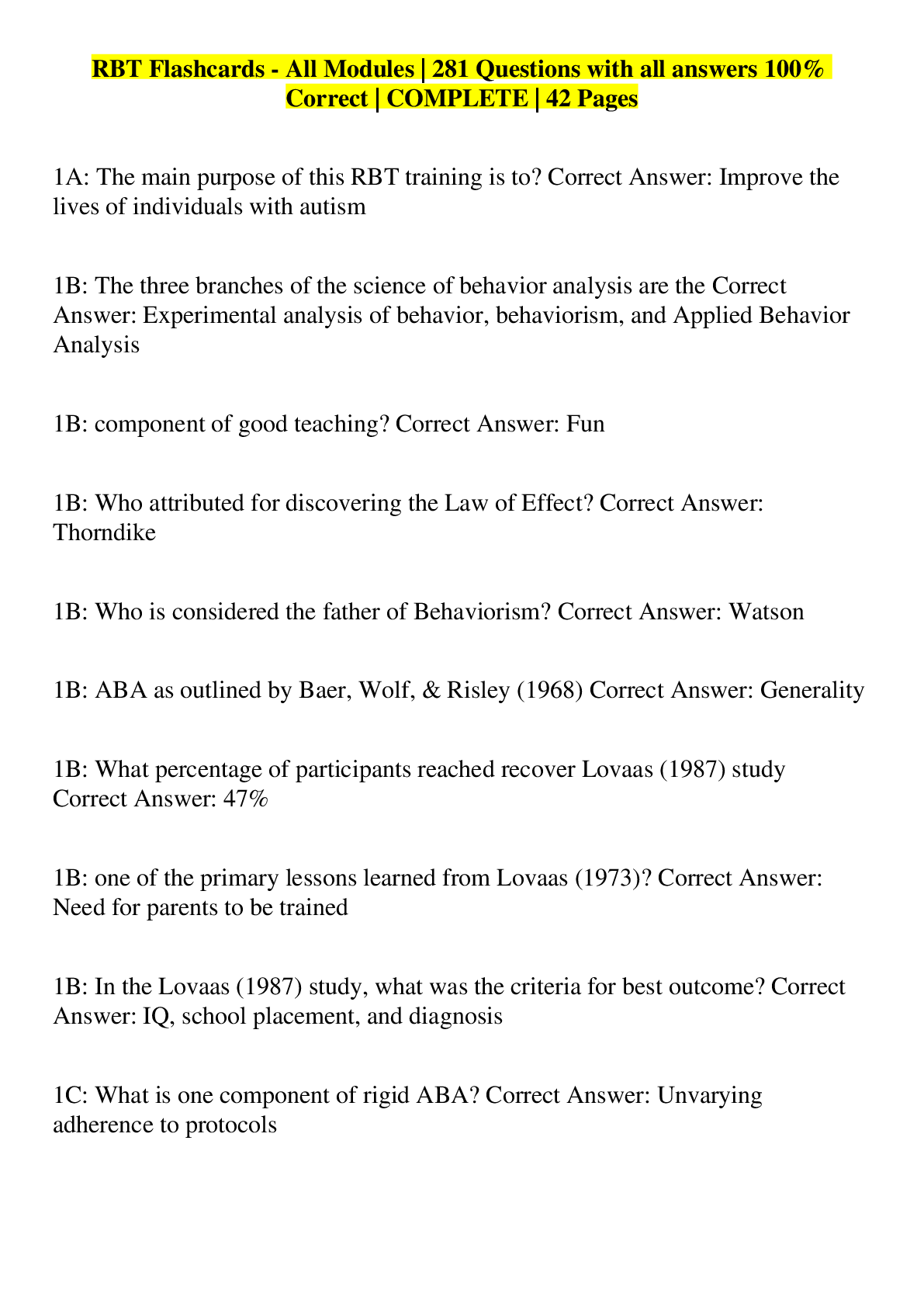
RBT Training Flashcards - RBT Training Modules | 281 Questions and Answers 100% Correct | COMPLETE | 42 Pages
1A: The main purpose of this RBT training is to? - ✔✔Improve the lives of individuals with autism 1B: The three branches of the science of behavior analysis are the - ✔✔Experimental analysis of beh...
By Tessa , Uploaded: Aug 08, 2022
$12
*NURSING> EXAM > Metaplastic cells are not better prepared to survive under stressful circumstances - Hypertrophy can occur under normal and pathological conditions- Cell proliferation is the process in which proliferating cells become more specialized cell types..Final Exam- Requires Respondus LockDown (All)

Metaplastic cells are not better prepared to survive under stressful circumstances - Hypertrophy can occur under normal and pathological conditions- Cell proliferation is the process in which proliferating cells become more specialized cell types..Final Exam- Requires Respondus LockDown
Question 1 2.5 / 2.5 pts True/False: Metaplastic cells are not better prepared to survive under stressful circumstances. True Correct! False Question 2 2.5 / 2.5 pts True/False:...
By Allan100 , Uploaded: Aug 04, 2022
$10
History> EXAM > SAE 3701 Exam -Before formal schools, indigenous education in precolonial societies was intertwined with -Education in precolonial communities involved (CONTAINS OVER 300 Q&A) (All)
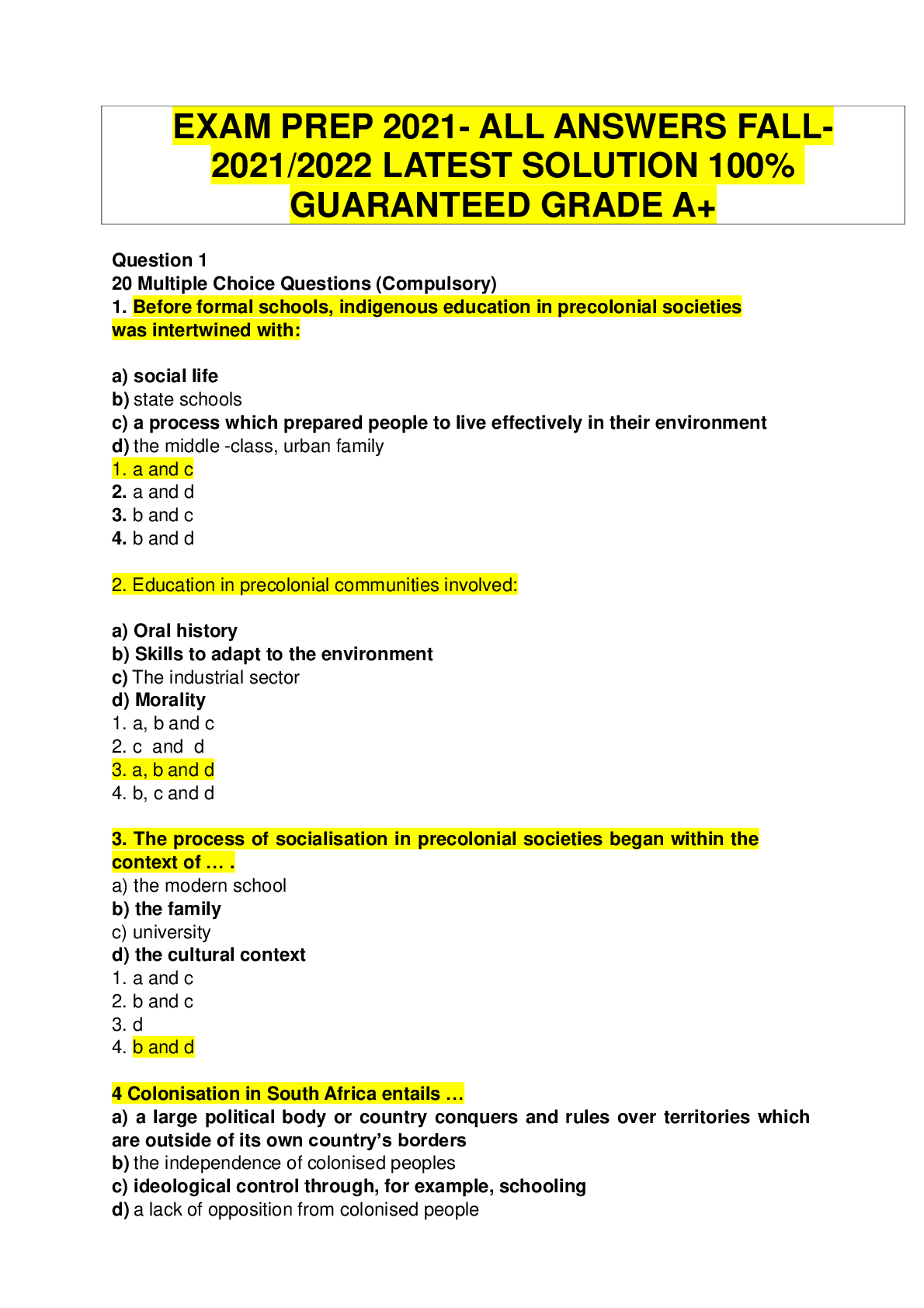
SAE 3701 Exam -Before formal schools, indigenous education in precolonial societies was intertwined with -Education in precolonial communities involved (CONTAINS OVER 300 Q&A)
Question 1 20 Multiple Choice Questions (Compulsory) 1. Before formal schools, indigenous education in precolonial societies was intertwined with: a) social life b) state schools c) a process wh...
By Allan100 , Uploaded: Aug 04, 2022
$8
*NURSING> EXAM > NUR2488 - NUR 2488 Mental Health Nursing Final Exam - Rasmussen (All)
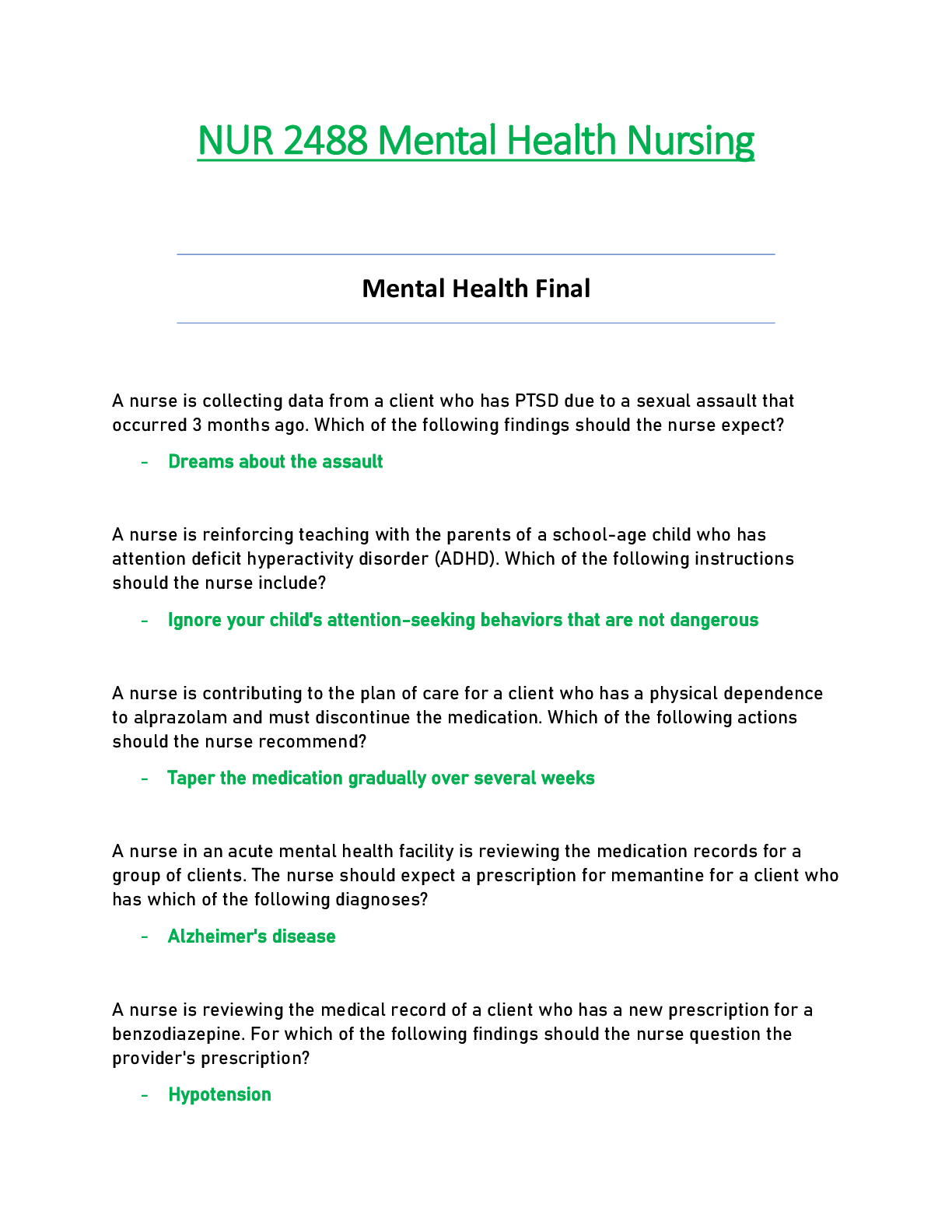
NUR2488 - NUR 2488 Mental Health Nursing Final Exam - Rasmussen
Mental Health Final NUR 2488 Mental Health Nursing Mental Health Final A nurse is collecting data from a client who has PTSD due to a sexual assault that occurred 3 months ago. Which of the...
By quiz_bit , Uploaded: May 30, 2021
$10
Mathematics> EXAM > Math 225n Statistics Quiz Week 6 (All)
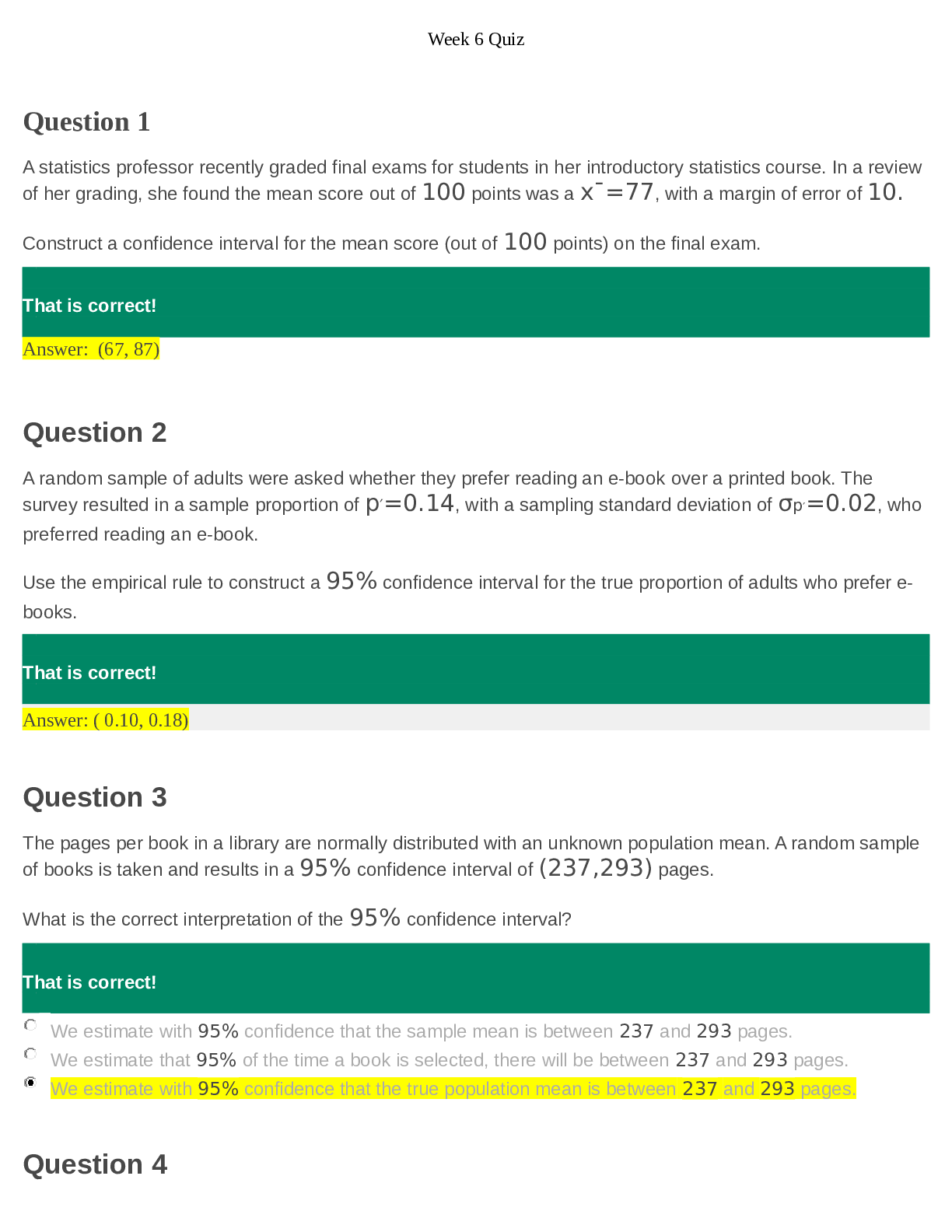
Math 225n Statistics Quiz Week 6
Question 1 A statistics professor recently graded final exams for students in her introductory statistics course. In a review of her grading, she found the mean score out of 100 points was a x¯=77, w...
By Dr Fiona , Uploaded: Jun 14, 2021
$11
*NURSING> EXAM > NUR2790 - NUR 2790 Final Exam Professional Nursing III / PN3 - Q & A Updated,Rasmussen (All)
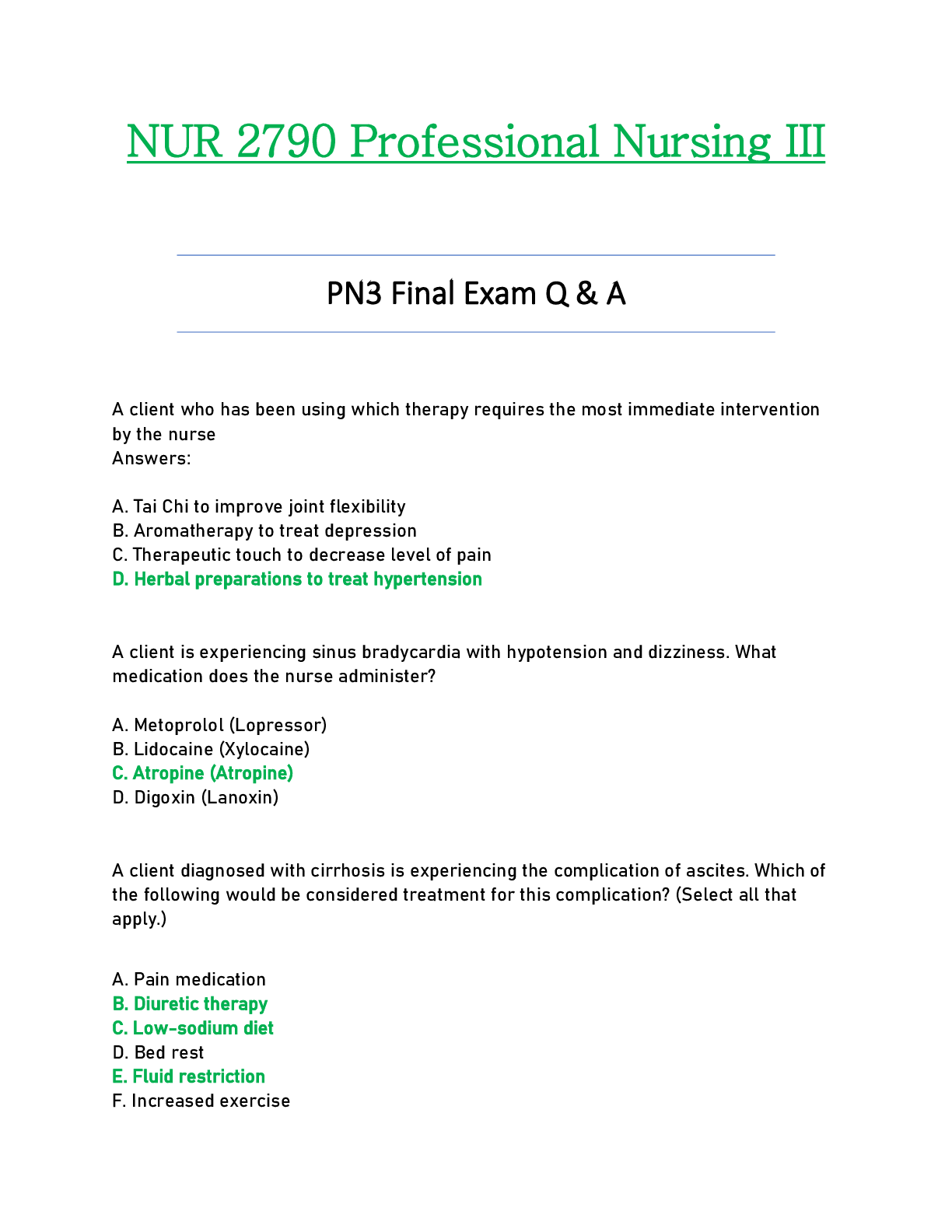
NUR2790 - NUR 2790 Final Exam Professional Nursing III / PN3 - Q & A Updated,Rasmussen
NUR 2790 Professional Nursing III / PN3 Final Exam Q & A NUR 2790 Professional Nursing III PN3 Final Exam Q & A A client who has been using which therapy requires the most immediate interve...
By quiz_bit , Uploaded: May 29, 2021
$10
Statistics> EXAM > MATH 225N Week 6 Statistics Quiz - Chamberlain College of Nursing. (All)
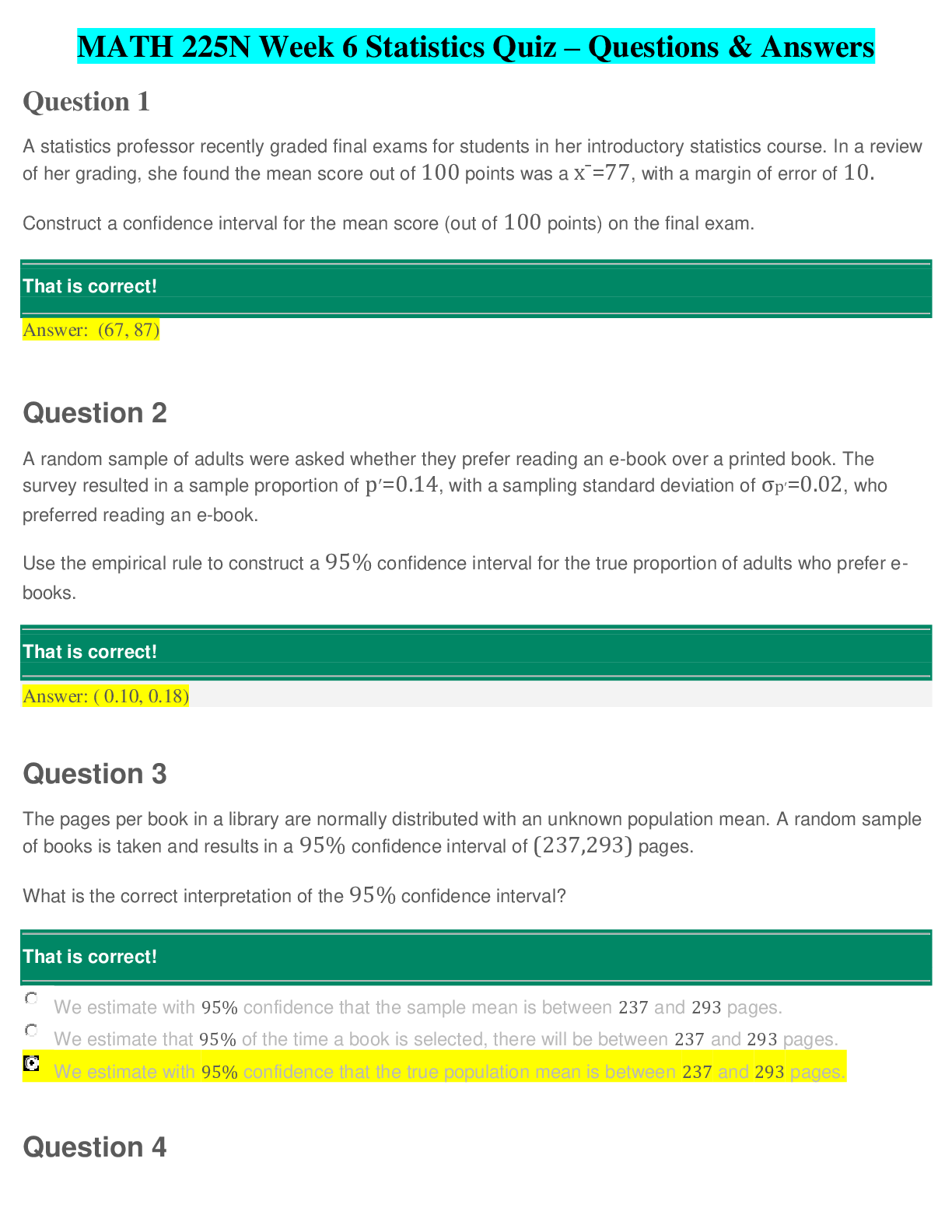
MATH 225N Week 6 Statistics Quiz - Chamberlain College of Nursing.
MATH 225N Week 6 Statistics Quiz (Questions & Answers) 1. Question: A statistics professor recently graded final exams for students in her introductory statistics course. In a review of her grading...
By Expert1 , Uploaded: Apr 26, 2020
$11
BioChemistry> EXAM > NUR 2356 - NUR2356 Multidimensional Care I Final exam Review / MDC I Final Exam | Rated A (All)
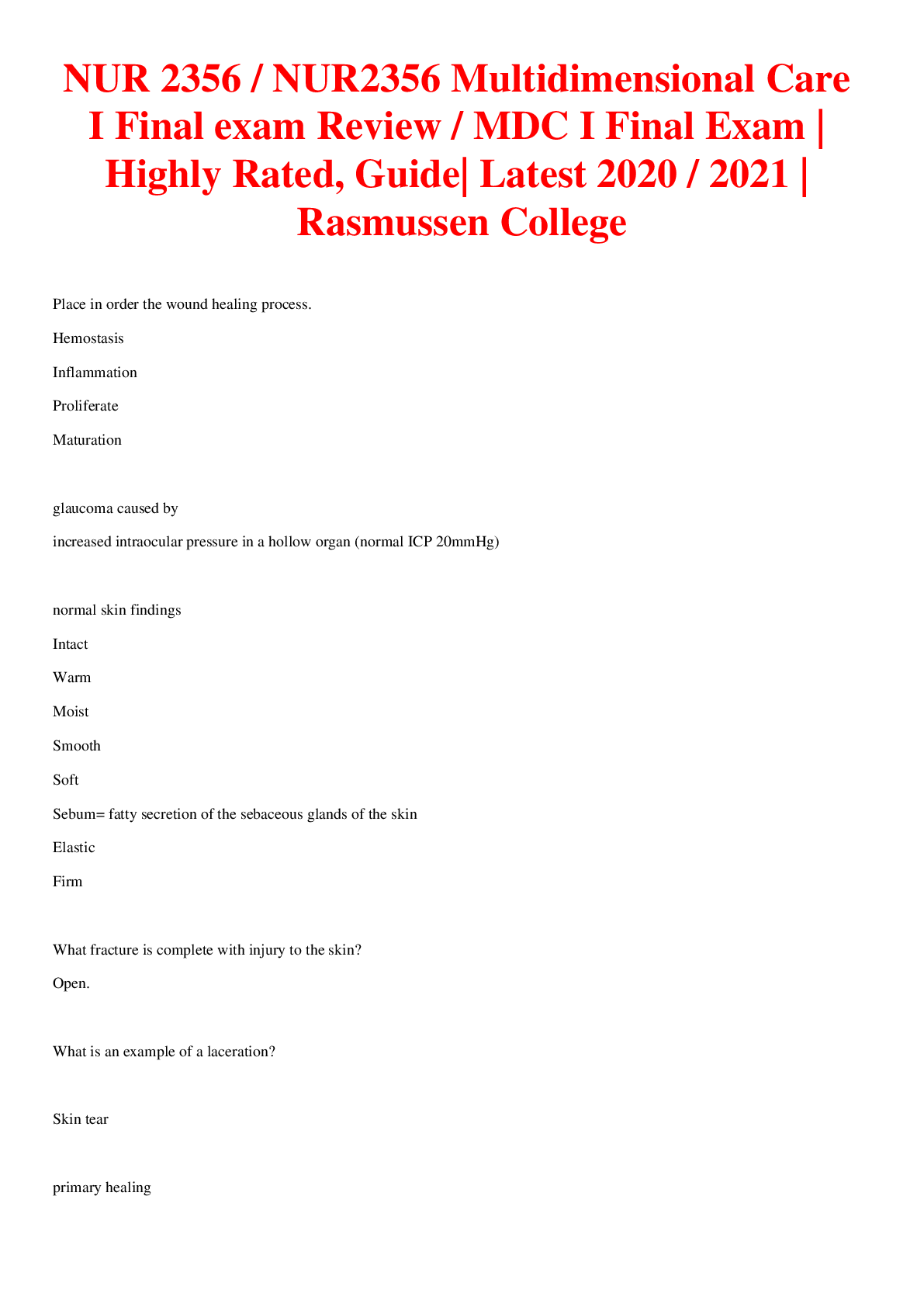
NUR 2356 - NUR2356 Multidimensional Care I Final exam Review / MDC I Final Exam | Rated A
NUR 2356 / NUR2356 Multidimensional Care I Final exam Review / MDC I Final Exam | Rated A, Guide| Latest 2020 / 2021 | Rasmussen College 1. The nurse should suspect ACS (acute compartment syndrom...
By nurse_steph , Uploaded: Nov 25, 2020
$11
Mathematics> EXAM > MATH 225N Week 6 Statistics Quiz with Answers. (All)
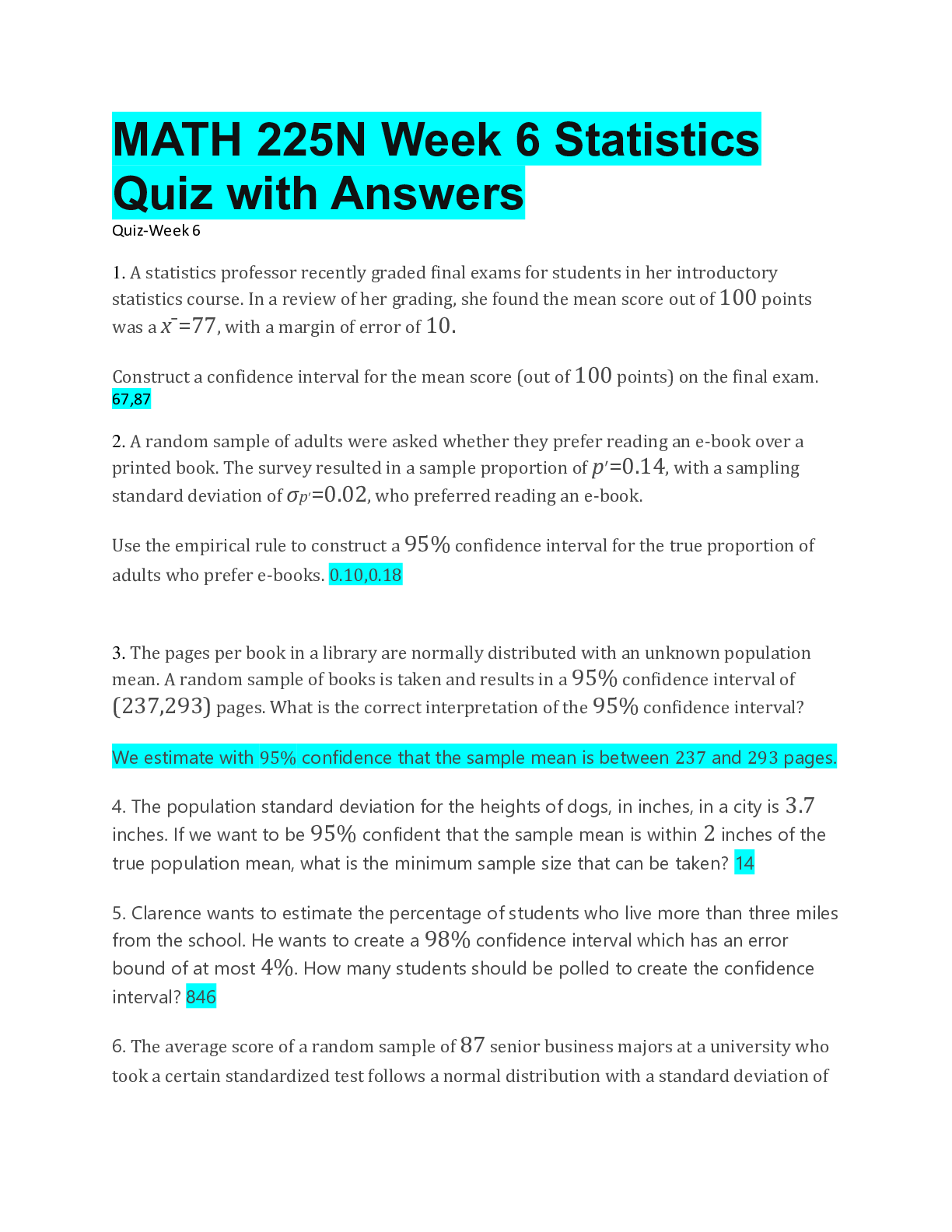
MATH 225N Week 6 Statistics Quiz with Answers.
MATH 225N Week 6 Statistics Quiz with Answers Quiz-Week 6 1. A statistics professor recently graded final exams for students in her introductory statistics course. In a review of her grading, she...
By Byde , Uploaded: Feb 20, 2021
$10
Law> EXAM > CSLB C10 CSLB C10 Test 1 | 120 Questions with 100% Correct Answers (All)
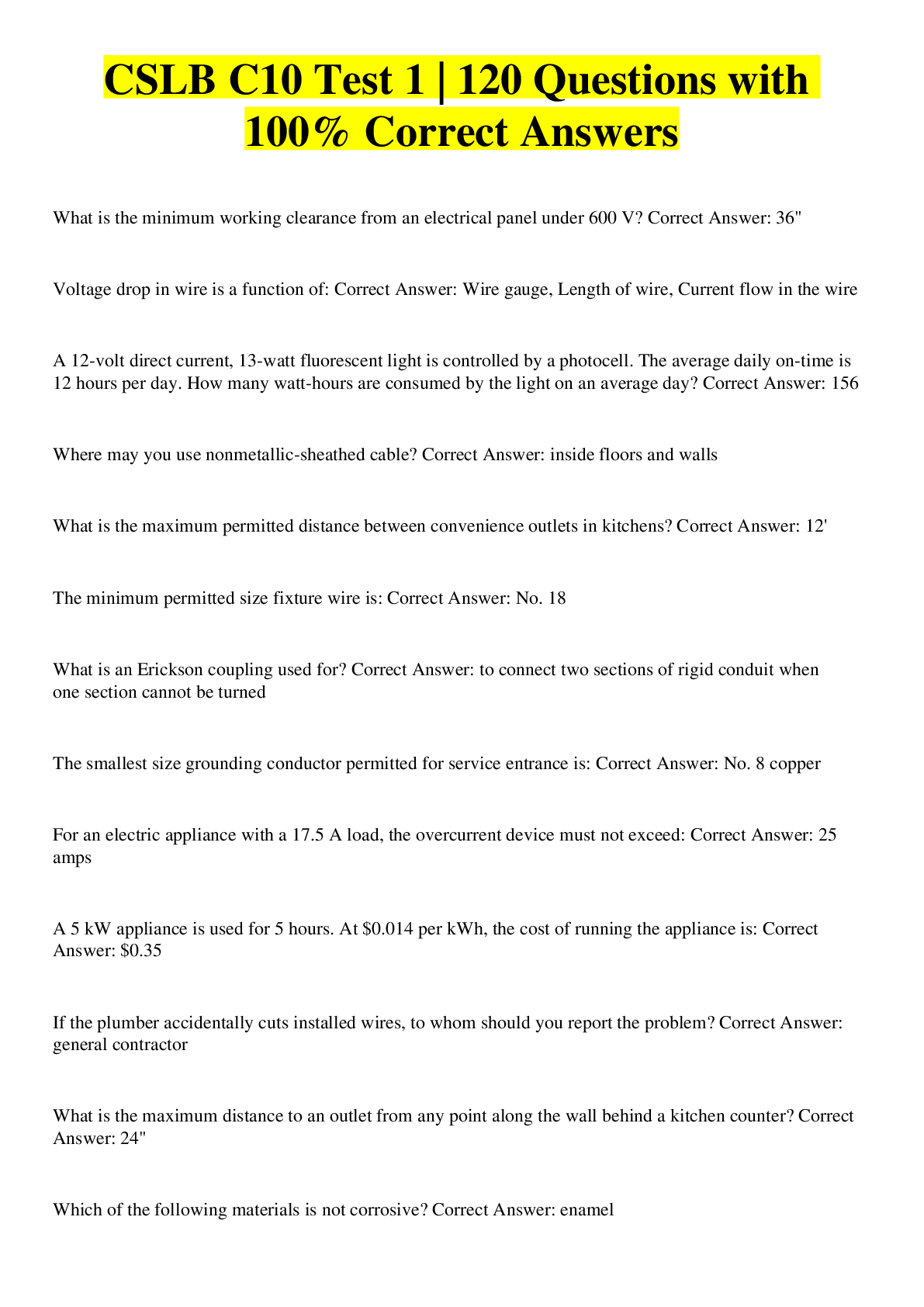
CSLB C10 CSLB C10 Test 1 | 120 Questions with 100% Correct Answers
What is the minimum working clearance from an electrical panel under 600 V? - ✔✔36" Voltage drop in wire is a function of: - ✔✔Wire gauge, Length of wire, Current flow in the wire A 12-volt direct...
By Tessa , Uploaded: Aug 08, 2022
$10.5
Document information
Connected school, study & course
About the document
Uploaded On
Apr 25, 2023
Number of pages
156
Written in
Additional information
This document has been written for:
Uploaded
Apr 25, 2023
Downloads
0
Views
75






